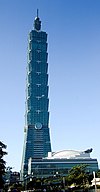Agriculture in Taiwan
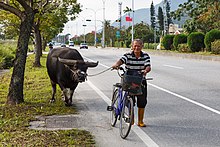
Agriculture is one of the main industries inTaiwan.It contributes to thefood security,rural developmentandconservationof Taiwan.[1]Around 24% of Taiwan's land is used for farming.[2]
Taiwan is a global leader invertical farmingandagritourism.
History
[edit]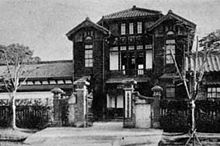
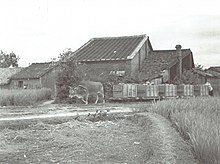
Prehistory
[edit]Agriculture has been an important sector of Taiwanese life since ages ago. From archaeological sites inChangbin Township,Taitung County,sincePaleolithic Agearound 30,000-50,000 years ago, people hunted, fished and gathered. Only in theNeolithic Agearound 5,000-2,000 years ago, did people began to live theirsedentary lifestylewhere they grew rice and other crops and domesticated animals. During theIron Agearound 2,000 years ago, people in the northern coast of Taiwan began to make iron tools and food production increased significantly. In the 17th century, people from China began to migrate to Taiwan where they fished, hunted and grew crops. Most of them settled in the area aroundTainan.[3]
Dutch Formosa
[edit]During theDutch Formosain the early 17th century, the Dutch promoted the production ofsugarcaneandrice.At that time, 119 km2of cultivated land in Taiwan belonged to theDutch East India Company.The Dutch exported Taiwan's agricultural products and importedpeas,tomatoes,wax applesandmangoesfromSoutheast AsiaandUnited Statesto Taiwan.[citation needed]
The Dutch introduced thedomestic turkeyto Taiwan.[4]
Ming Dynasty
[edit]During the rule ofKoxingain theKingdom of Tungningin the late 17th century, the number of immigrants from China to Taiwan increased to 200,000 people. This resulted in the increase of land under cultivation to 292 km2.Koxinga established aland tenuresystem and taught people to buildreservoirsforirrigation.Ricewas the main produce at that time. Chinese people also brought 43 kinds ofvegetablefromSouth China,such asleeks,garlicandChinese cabbage.
Qing Dynasty
[edit]During theQing Dynasty,immigration from Mainland China to Taiwan increased because of wars and famines in the mainland. People began to buildcanalsfor irrigation. At this time, the cultivated land in Taiwan increased to 3,506 km2by 1895.
The eighteen century official Chiang Yun-chuan was responsible for significant improvements in irrigation and flood control in southern Taiwan and was incorporated into the localfolk religionas a deity.[5]
Empire of Japan
[edit]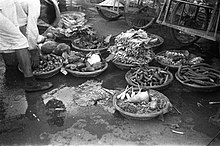


During theEmpire of Japan,the Japanese greatly improved the agriculture sectors in Taiwan. They built concretedams,reservoirs andaqueductswhich forms an extensive irrigation system, such as theChianan Irrigation.Arable landfor rice and sugarcane productions increased by more than 74% and 30% respectively. They also established farmers' associations. Agriculture sector dominated the economy of Taiwan at that time. In 1904, 23% area of Taiwan was used as agricultural land.[6]
TheTaiwan Agricultural Research institute(TARI) was founded in 1895 by the Japanese colonial powers.[7]
By 1939 Taiwan was the third largest exporter of bananas and canned pineapple in the world.[8]
Republic of China
[edit]
After thehandover of Taiwan from Japanto theRepublic of Chinain 1945, the government revitalized the agricultural sector first to recover from the damage caused byWorld War IIand completed a full recovery by 1953.
In the early 1950s, agriculture was Taiwan's largest economic sector and the vast majority of Taiwanese were farmers.[9]
The government extended agricultural facilities and introduced theland reformprogram under theSino-American Joint Commission on Rural Reconstruction.By 1956, agricultural land accounted for 34% of Taiwan's land use.[6]
In the late 1940s, Taiwan underwent high-speed economic growth and industrialization. In 1963, industrial sectors outputvalueexceeded agricultural sectors output value. Also in the 1960s, the government shifted their priority to the development of export-oriented economic policy which focused onlabor-intensiveindustries, such astextiles,convenience foodandconsumer electronicswhich eventually made Taiwan part of theFour Asian Tigers,along withBritish Hong Kong,SingaporeandSouth Korea.However, this caused pressure on the agricultural sector as more and more people moved away from rural areas and labor costs increased.[citation needed]
In the 1970s, the role of agriculture shifted from the primary focus of the economy to a supporting role. The government at that time issued policies for farmers to grow organic crops. In the 1980s, much farmland was left idle due to the emigration of people from rural to urban areas as well as Taiwan beginning to open up to staple food imports. On 1 January 2002, Taiwan joined theWorld Trade Organizationunder the nameSeparate Customs Territory of Taiwan, Penghu, Kinmen and Matsu.This accession caused further damage to the agricultural sector in Taiwan. In response, the government has promoted agricultural tourism.[10]
PresidentLee Teng-huibelieved that agriculture was the backbone of a nation and promoted it extensively. He implemented health insurance and occupational hazard insurance programs for farmers. He also emphasized the Japanese roots of much of Taiwan's agricultural infrastructure.[11]
While the importance of agriculture to the Taiwanese economy has declined greatly from its heyday Taiwan has become a global leader in the vertical farming industry. Due to their efficient development of vertical farming technology and know-how Taiwanese firms are often partnered with by international firms looking to start vertical farming ventures in their home countries. The vertical farming industry benefits from the high concentration of LED, robotics, engineering, and data processing firms in Taiwan.[12]Vertical farms in Taiwan primarily compete with imported produce and focus on producing premium vegetables as their products remain more expensive than those from Taiwan's traditional farms.[13]
Recently, the government has introduced new policy to reactivate all of the remaining idle farmland to ensure food security, food self-sufficiency and to revitalize the agriculture sectors. Policies to develop the sector to be more competitive, modern and green were also introduced. This has led to a large number of urban youth taking up farming. Since 2009 the Agriculture Council has subsidized education and training for new farmers, most of whom already hold advanced degrees.[14]
In 2020 the Taiwanese government's Council of Agriculture set aside NT$5 billion (US$166.21 million) in loans for produce, livestock and aquaculture operations as well as other agriculture-based enterprises effected by theCOVID-19pandemic. The loans are at a preferential rate of 0.79 percent to 1.68 percent.[15]
In 2021 the Taiwanese government began incentivizing rice farmers to diversify their production beyond the staple crop.[16]
Government
[edit]
Agriculture-related affairs in Taiwan are handled byCouncil of Agriculture(COA), headed by MinisterChen Chi-chung,and its divisionAgriculture and Food Agency.[17]Taiwan houses the headquarter of the World Vegetable Center.[18]Taiwan is also a member of world organizations related to agriculture, such asAfro-Asian Rural Development Organization,Asia-Pacific Economic Cooperation,International Commission for the Conservation of Atlantic TunasandWorld Trade Organization.[citation needed]
Produce
[edit]In 2013, there are four main agricultural produce sectors in Taiwan, which are plant crops (47.88%),livestock(31.16%),fishery(20.87%) and forest (0.09%). The total annual agriculture produce production is around 6.9 million tons.[19]
Rice
[edit]
In 2013, Taiwan harvested more than 1.6 million tons of riceyieldfrom 2,703 km2of land with a total value of NT$36.9 billion. It is the most valuable cash crop in Taiwan.[20]The quality of Taiwanese rice is extremely high.[21]
Before the Japanese colonial period most rice grown in Taiwan was long-grained Indica rice, the Japanese introduced short-grained Japonica which quickly changed both the farming and eating patterns of the Taiwanese.[21]
Betel nuts
[edit]In 2001, Taiwan harvested 165 thousand tonnes ofbetel nutsfrom more than 500 km2of land, the second most valuable cash crop after rice.[22]
Cocoa
[edit]Cocoa cultivation on Taiwan began during the Japanese period but support ended after WWII. The next wave of cultivation occurred in the 1970s but petered out because farmers lacked the expertise necessary to process the raw beans. The modern industry was kickstarted by Chiu Ming-sung a betel nut farmer andchocolatierfrom Pingtung who in 2007 became the first on Taiwan to make tree-to-bar chocolate.[23] Taiwan's cocoa production is centered in Pingtung in Southern Taiwan. Because of high production costs and small farm size Taiwanese cocoa producers focus on producing estate-grade beans.[24]In Pingtung county cocoa is generally grown as acompanion cropto betel nut as the tallbetel nut palmsshade the cocoa plants. As of 2020 approximately 200-300 acres was under cultivation in Pingtung supporting around 30 chocolate making companies.[23]
Chocolate industry
[edit]The cocoa industry supports a significant domestic cocoa processing and chocolate making industry.[24]Taiwan is one of the few mature chocolate making countries to also be a cocoa producer.[23]In 2021 Taiwan tightened the labelling regulations for chocolate.[25]
Coffee
[edit]The first coffee plants on Taiwan were imported by the British to Tainan in 1884 with the first significant small scale cultivation taking place in New Taipei City'sSanxia District.Tainan remains the heart of Taiwanese coffee culture.[26]
Commercialcoffeeproduction in Taiwan began during the Japanese colonial period.[26]The Japanese developed the industry to feed the export market.[27]Production reached a peak in 1941 following the introduction ofarabica coffeeplants. Production declined shortly thereafter as a result of World War II.[26]Domestic production is small but of high quality, imported beans account for the vast majority of coffee sold in Taiwan. In 2016 domestic production was 900 tons while 30,000 tons was imported.[28]
Thecoffee borer beetleis a significant pest in Taiwan.[29]
Tainung No. 1 is the first popular domestically bred coffee cultivar. It can be grown at lower altitudes than most coffee varieties and produces excellent quality beans.[27]
Fruits
[edit]
In 2013, Taiwan harvested 2.68 million tonnes of fruits from 1,844 km2of land with a total value of US$191 million. Taiwan's fruit crops includebanana,grape,guava,jujube,lychee,mandarin orange,mango,orange,papaya,pineapple,pomelo,sand pear,dragonfruit,starfruit,strawberry,watermelonandwax apple.The annual fruits export is 60,000 tons with a value of NT$3,452 million. In 2018 largest export market of Taiwanese fruits wasChina.[30]In 2022 the largest export market of Taiwanese fruits was Japan.[31]
Avocados
[edit]Most avocado varieties grown in Taiwan produce large fruit. Domestic avocados compete with imported American hass avocados in the local market. Cultivation grew from 506 hectares in 2011 to 1,149 hectares in 2020 due to rising popularity.[32]
Bananas
[edit]Bananas are Taiwan's most important export fruit. TheTaiwan Banana Research Instituteis tasked to undergo research and development of banana cultivation in Taiwan.[33]
Citrus
[edit]By 1984 there were 34,000 hectares of citrus orchards in Taiwan annual yields of 360,000 metric tons with mandarin oranges and tangerines leading in production.[34]In 2008 a glut in orange production forced the export of surplus fruit to China. PresidentMa Ying-jeoueven personally contributing $80,000 NTD to support an orchard in Gukeng township in Yunlin County as a result of the glut.[35]
The average pomelo harvest is 74,000 tonnes.[36]Pomelos are exported to China and Japan. Tainan is a major pomelo growing area.[37]Greenpeace has warned that global warming could negatively impact Taiwanese pomelo production.[36]
In 2018 there were 2,737 hectares of lemons in cultivation with 1,820 of those located in Pingtung County.[38]
Taiwan produces a small amount ofAustralian finger lime.[39]
In 2022 China blocked the importation of Taiwanese citrus due to tensions over the2022 visit by Nancy Pelosi to Taiwan.This affected the pomelo industry in particular due to the ban's timing and its exposure to the Chinese market.[40]
Custard apples
[edit]
Production ofcustard applesin concentrated in Taitung County, Kaohsiung, and Pingtung County. Annual production is 57,000 metric tons. Historically, 23% of production was exported to China, but Chinese authorities banned new imports of Taiwanese custard apples in 2021.[41]
Dragonfruit
[edit]Pingtung is the center of dragonfruit cultivation which is known locally as pitaya. AcademicYen Chung-Rueyis known as Taiwan's “Father of Pitaya.”[42]Most of the production is consumed domestically but dragonfruit are also exported to Canada, China and Hong Kong.[43]
Guavas
[edit]Guavas are a significant product with a little over half of exports going to Canada, in 2019 Taiwan received permission to export guavas to the United States for the first time.[44]
Mangos
[edit]Mangos have been cultivated in Taiwan for more than 400 years. For the last fifty years the market has been dominated by theIrwin mango.The Irwin mango was first grown in Taiwan in 1962 by Cheng Han-chih ( trịnh hãn trì ) in Douliuzai Village,Yujing District, Tainan.In 1973 the government designated Douliuzai Village as a mango special agricultural zone. By the 1970s the residents of Douliuzai Village were known for their wealth due to mango cultivation. Cheng Han-chih is considered to be the godfather of the lucrative modern mango industry. The traditional variety of mango, known as the “native mango” ( thổ mang quả ), is smaller and more fibrous than modern varieties due to this they are oftenpickledorcandied.[45]
Papaya
[edit]The papaya cultivarPapaya No. 7is a significant cash crop in Pingtung.[42]
Pineapples
[edit]
Taiwan is a significant producer ofpineapples,with production primarily occurring in Pingtung and other southern regions.[46]Pineapples make up 40% of Taiwan's fruit exports by value.[47]
In 2021 China banned the importation of pineapples from Taiwan just as the season was beginning claiming that previous imports had been contaminated with pests, claims questioned or denied by experts, producers, and the Taiwanese government. In response to the ban the Taiwanese government asked the Taiwanese people and diplomatic allies to increase their consumption of Taiwan's “Freedom Pineapples” and promised financial assistance to any farmers who saw losses as a result of the ban.[47]The “Freedom Pineapples” initiative received support from allies such as Canada and the United States with the Canadians referencing the Canadian inventionpineapple pizza.[48]The Freedom Pineapple campaign was launched by Foreign MinisterJoseph Wuon Twitter.[49]
Lychee
[edit]Lycheeproduction is significant with more than 3,000 hectares under cultivation in Kaohsiung alone. The two main varieties are Heiyezi and Yuhebao. Production was reduced in 2021 due to drought.[50]
Viticulture and winemaking
[edit]Independentwinemakingwas illegal in Taiwan for a long time due to the monopoly granted to theTaiwan Tobacco and Liquor Corporation.[51]Taiwan Tobacco and Liquor Corporation produced just one wine, arosé.With liberalization following the end of military rule independent winemakers became legal in 2002 and in 2014 a Taiwanese wine won its first gold medal at an international competition. The primary grapes cultivated for winemaking in Taiwan are Black Queen and Golden Muscat which were both introduced to the country in the 1950s.[52]A red wine from Taichung was awarded a gold medal at the 25th Vinalies Internationales in France.[53]In 2020 Taiwanese wines won two gold medals at the 26th Vinalies Internationales Competition.[54]Grape harvest in Taiwan is dictated by the typhoon season which means growers are sometimes forced to pick less than ripe fruit. Two of the most acclaimed wineries are Domaine Shu Sheng and Weightstone Vineyard Estate & Winery.[55]The relative rarity and high quality of Taiwanese wines makes them particularly prized by Hong Kong collectors.[51]Although it was once largely lost Taiwan's indigenous winemaking culture is staging a comeback.[56]
Wax apples
[edit]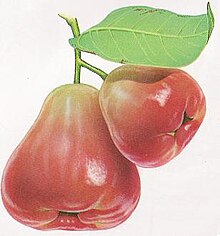
Wax applesare a significant crop in Taiwan. Taiwanese researchers have bred firmer, larger, and more deeply red varieties of the wax apple to appeal to the local market and growing conditions. This has led some to inaccurately believe that wax apples themselves were invented in Taiwan. The varietyBlack Pearlis highly valued.[42]
Production of wax apples in concentrated in Taitung County, Kaohsiung, and Pingtung County. Annual production is 47,000 metric tons. Historically, 10% of production was exported to China, but Chinese authorities banned new imports of Taiwanese wax apples in 2021.[41]Pingtung's southern coast is particularly productive for wax apples as the trees perform favorably in slightly saline conditions.[42]
Indian jujube
[edit]Indian jujubeproduction in Taiwan is significant. Productions is centered in Kaohsiung with 750 hectares, 40% of the national total, of Indian jujubes. The annual production value is 1b NTD.[57]
Strawberries
[edit]The most commonly cultivated strawberry variety in Taiwan is theTaoyuan No. 1( đào viên 1 hào ).[58]
Mushrooms
[edit]Wild mushrooms and fungus were widely consumed by the indigenous people of Taiwan as well as being used for medicinal and spiritual purposes. Commercial mushroom farming on Taiwan can be traced to methods introduced during the Japanese period. The industry took off in the 1950s after being targeted by the U.S.-ROC Joint Commission on Rural Reconstruction (JCRR) for development. Exports of canned mushrooms began in 1960 and by 1963 Taiwan was the world's top mushroom exporter with a third of the global market. Exports of canned mushrooms peaked in 1978 before declining as production shifted to lower cost countries. Today the vast majority of mushrooms produced on Taiwan are consumed locally but due to high mushroom consumption the industry is very large.[59]Mushrooms account for 18% of the value of Taiwan's non-meat food production.[60]New farming methods and localized marketing have allowed traditional producers to remain competitive with large industrialized producers.[61]
Vegetables
[edit]
In 2013, Taiwan harvested 2.75 million tonnes of vegetables from 1,460 km2of land with a total value of US$170 million. Major vegetables cultivated includebroccoli,cabbage,carrot,chayote,Chinese cabbage,edamame,eggplant,kai-lan,onion,scallionandspinach.Vegetable plantation areas are mostly located in central and southern Taiwan. The peak harvest time is during the autumn and winter seasons.[62]
Vegetable production is increasingly the focus ofurban agricultureincludingvertical farmingdue to the desire to maximize crop yield from relatively small plots without using excessive amounts of pesticides or fertilizers. Increased production is also driven by a desire to minimize Taiwanese dependence on other countries as sources of fresh produce, especially high value vegetables.[63][64]Taiwan's vertical vegetable farms are some of the most advanced in the world.[65]Taoyuan's iFarm was Asia's largest vertical farm when it opened in 2018.[66]
Sweet potatoes
[edit]Sweet potatoeshave been grown in Taiwan since at least 1603 following their introduction to Asian by the Spanish. However the possibility exists that the sweet potato reached Taiwan before the Spanish colonization of the new world. It rapidly became a staple of local diets. Poor families would often mix sweet potato into their rice or millet to stretch it out. Unlike the other staples of rice and millet, sweet potatoes could be grown on hillsides with limited preparation. Cultivation of sweet potato reached its height during the Japanese colonial period with Taiwan ranking fourth in output from 1934 to 1938 after China, Japan, and the United States with 3.7% of world production. Production fell as a result of World War II and economic disruption. It took off again in the 1950s and 1960s but with most of the crop destined to feed hogs not people. Production fell again after commercial swine producers switched to imported grains like corn for their feed. In modern Taiwan sweet potatoes are grown as a root vegetable, as a leaf vegetable, and for their starch. 40% of the crop is exported to Singapore and Hong Kong with the rest being consumed domestically either fresh or processed. Sweet potatoes are associated with poverty and their consumption is avoided by many elders however sweet potatoes continue to play an important part in Taiwanese cuisine.[67]
Research into the sweet potato at the Chiayi research station of the Taiwan Agricultural Research institute began in 1922. For the first 20 years after its founding in 1971 theWorld Vegetable Centerwas a major global sweet potato research center with over 1,600 ascensions in their first two years of operation. In 1991 the World Vegetable Center chose to end its sweet potato research due to high costs and other institutions with a tighter focus coming into existence. The WVC duplicated and transferred its research and germplasm to theInternational Potato Centerand Taiwan Agricultural Research institute.[67]
The counties of Yunlin, Taichung, Miaoli and Changhwa are the main sweet potato producers.[68]Hualien county is known for its unique varieties of sweet potato.[69]
Tea
[edit]
In 2013, Taiwan harvested about 15,000 tons of tea with a total value of NT$6.92 billion, of which 3,919 tons was exported. Taiwan's tea produces areoolong tea,pouchong tea,green teaandblack tea.Taiwan began cultivating tea around two hundred years ago.[70]
Flowers
[edit]
In 2013, Taiwanharvestedflowerswith a total value of NT$16.52 billion, in which US$189.7 million of it was exported. Flower plantation land spreads over an area of 138 km2.Chrysanthemumfloriculture takes the most land share among other types of flowers. Taiwan is the world's largest exporter oforchids,which represented 87% of the flower export value in 2013. The main export markets for Taiwanese flowers are theUnited States,Japanand theNetherlands.[71]
The export oriented flower market suffered during theCOVID-19 pandemicwith an increase in domestic consumption and government support necessary to keep the industry profitable.[72]
TheTaipei Flower Marketis the largest plant and flower market in Taiwan.[72]
The Taiwan Floriculture Development Association is the primary industry association.[72]
Livestock and poultry
[edit]
In 2013, Taiwan producedlivestockandpoultrywith a total value of NT$150 billion. Taiwan's major livestock arepigs,and the major poultry is chickens, both asbroilersandeggs.Taiwan exported 10,890 tons of animal products and imported 295,063 tons.[citation needed]90% of pork consumed in Taiwan is domestically produced.[73]
TheGiant African snailwas introduced to Taiwan by the Japanese in 1932 and have since formed a significant part of rural food culture. Only since the advent of commercial farming of the white-jade variety in the 1980s has consumption become widespread.[74]
Taiwan is a significant goat producer but produces few sheep, the mandarin for both species is yang ( dương ) which leads to little distinction between them in cuisine. Most local meat sold as mutton in Taiwan is in fact goat.[75]
Pigs
[edit]Pork production peaked in the years before 1997 whenfoot-and-mouth diseasearrived in Taiwan. In those years Taiwan was the second largest exporter of pork after Denmark.[8]The traditional method of feeding pigs with food scraps has been restricted to the most advanced farms due to concerns aboutAfrican swine fever.In 2020 three quarters of Taiwan's pork farmers produced less than 1000 pigs a year.[76]
Poultry
[edit]Chicken and egg producers have had a hard time scaling to meet demand because of issues with disposing of large amounts of waste products. Taiwan imports some of its eggs.[77]In 2022 daily egg consumption was 24 million and local production was 22.6 million.[78]
Geese are a significant part of Taiwan's livestock and cuisine.[79]
Turkeys have been raised in Taiwan since partial Dutch colonization, production increased in the 1950s due to demand from US soldiers newly stationed in Taiwan. Turkey production remained significant after the drawdown in US forces.[80]
Fisheries and aquaculture
[edit]
Aquaculture has a long history in Taiwan.[81]By 2006 the production of Taiwanese coastal aquaculture was valued at NT$11,817 million.[82]
In the 21st century high technology is playing a greater part in Taiwan's aquaculture industry as the industry struggles to cope with labor shortages and fierce foreign competition. The Taiwanese government operates six fisheries and aquaculture research centers.[83]
The Aquaculture Taiwan Expo & Forum is the primary aquaculturetrade showin Taiwan, it is held concurrently with the Livestock Taiwan Expo & Forum and the Asia Agri-Tech Expo & Forum.[84]
Taiwan is one of the largest fishing nations on earth and the associatedfish processingindustry is also significant.[85]More than one third of the worldslonglinetuna fishing vessels are operated by Taiwanese companies with the total strength of the distant waters fishing fleet at more than 2,000 vessels. The fishing industry is estimated to be worth approximately two billion dollars.[86]Taiwan's ocean fisheries sector employs 350,000 people and there are 130,000 fishing households in Taiwan.[83]
Economy
[edit]
In 2013, agriculture sector contributes around 1.69% of itsgross domestic product(GDP) with a total value of NT$475.90 billion.[87]Combined with agriculture-related tourism sector, it contributes to 11% of Taiwan's GDP. Taiwan exports around US$5 billion worth of agricultural products annually toCanada,Mainland China,Japan,Middle EastSingaporeandUnited States.[citation needed]
Manpower
[edit]The agriculture sector employs around 540,000 people in Taiwan, about 5% of the total population. In 1997, there were around 780,000 farm households, in which 80% of them were part-time farm households. There are 1.1 hectares of cultivatable land per farm family.[88]
Finance
[edit]
Agricultural financing system consists of the Agricultural Bank of Taiwan (Chinese:Toàn quốc nông nghiệp kim khố) and credit departments of farmers' and fishermen's association which falls under the supervision of the Bureau of Agriculture Finance (Chinese:Nông nghiệp kim dung cục) of the COA. Agricultural Credit Guarantee Fund (Chinese:Nông nghiệp tín dụng bảo chứng cơ kim) is responsible for financing farmers without enoughcollateralto acquireworking capital.[citation needed]
Trade events
[edit]- Nantou Global Tea Expo (Chinese:Nam đầu trà nghiệp bác lãm hội)[89]
- The Aquaculture Taiwan Expo & Forum, the Livestock Taiwan Expo & Forum and the Asia Agri-Tech Expo & Forum are all held concurrently.[84]
Organizations
[edit]
There are government-assisted farmer organizations around Taiwan which gives general assistance to farmers, such as supply, distribution, financial services etc. Farmer organizations in Taiwan consists of 302 farmers' associations, 40 fishermen's associations and 17 irrigation associations.[citation needed]
Politics
[edit]Taiwan has one agrarian political party, theTaiwan Farmers' Party,established on 15 June 2007. However, the party currently has no representative in theLegislative Yuan.[citation needed]
Research
[edit]
There are 16 research institutes established under the COA aimed to the development and innovation of technologies in agriculture-related produce. In 2013, there are 123 agriculturaltechnology transfersto the private sectors withroyalty paymentof around NT$84 million.[citation needed]
Research centers
[edit]- Kinmen Fisheries Research Institute
- Taiwan Banana Research Institute
- Taiwan Livestock Research Institute
- Taiwan Sugar Research Institute
- Tea Research and Extension Station
Technology
[edit]Spatial planning
[edit]Spatial planningfor agricultural farms in Taiwan is embedded into the Taiwan Agriculture Land Information Service (Chinese:Đài loan nông địa tư tấn phục vụ võng) whose data is collected byFormosat-2earth observation satellite.Information of farmland availability,soilproperties, cropping suitability,irrigationinfrastructures,land usezoning, andland consolidationare available for public access.[citation needed]
Security
[edit]
In 2020, the food self-sufficiency of Taiwan was 35%.[90]President Tsai Ing-wen has stated that she hopes Taiwan's food self-sufficiency can be raised to 40% in the near term.[91]
As of 2021 the nation's rice reserves were large enough to feed the country for 18 months with fruit and vegetable reserves of six months.[92]
Energy usage
[edit]In 2014, agriculture sector consumed a total 2,832.9 GWh of electricity.[93]Between 2000 and 2009, annual agricultural sector in Taiwan consumed 15.81 billion tons of water.[94]
Tourism
[edit]This sectionneeds additional citations forverification.(February 2021) |

Over the past few years,agritourismhas become more and more popular in Taiwan. The government has built recreational areas around farms and fishing villages by integrating the produce, nature and festivals. In 2013, there are more than 75 recreation farming zones have been established and there are almost 317 recreational farms have been licensed. Food-related museums are also plenty in Taiwan.
Agritourism forms a significant part of the total revenue for the agricultural industry. Many small family farms rely on tourism as their primary means of earning an income. Leisure farms, farm tours, farm stays, and other tourism related activities are popular both with domestic Taiwanese travelers and with international ones. The Taiwanese Agritourism industry has received significant state support.[95]In 2018TreeHuggerranked Taiwan the #1agritourismdestination in the world.[96]
Fruit tourismis a subsection of agritourism with fruit picking being the prime attraction. Taiwan's diverse subtropical climate means that there is always some sort of fruit in season. Fruit tourism is popular with both domestic and international tourists.[97]The region of Pingtung in particular is a fruit tourism destination.[42]
Farms
[edit]Erjie Rice Barn,Flying Cow Ranch,Fushoushan Farm,Fuxing Barn,Jingzaijiao Tile-paved Salt Fields,Qingjing Farm,Rareseed Ranch,Shangri-La Leisure Farm,Shanlong Vegetable Park,Toucheng Leisure Farm,Tsou Ma Lai FarmandWuling Farm.
In 2021 as a result of the tourism downturn due to the COVID-19 pandemic the Council of Agriculture announced subsidies for leisure farms.[98]
Converted farmlands
[edit]Aogu WetlandandChukou Nature Center.
Museums
[edit]
Chihsing Tan Katsuo Museum,Coca-Cola Museum,Honey Museum,Kuo Yuan Ye Museum of Cake and Pastry,Ping Huang Coffee Museum,Ping-Lin Tea Museum,Soya-Mixed Meat Museum,Soy Sauce Brewing Museum,Spring Onion Culture Museum,Taiwan Mochi Museum,Taiwan Nougat Museum,Taiwan Salt Museum,Taiwan Sugar Museum,Teng Feng Fish Ball Museum,Wu Tao Chishang Lunch Box Cultural History Museum,Yilan Distillery Chia Chi Lan Wine Museum,Republic of Chocolate,andZhuzihu Ponlai Rice Foundation Seed Field Story House.
See also
[edit]References
[edit]- ^"14670.pdf"(PDF).Archived fromthe original(PDF)on 2016-03-07.Retrieved2016-03-03.
- ^"Agriculture - Taiwan - export, average, growth, crops, annual, farming".
- ^"National Museum of Natural Science -> Exhibition -> Permanent Exhibits -> Gallery of Agricultural Ecology".Archived fromthe originalon 2019-03-16.Retrieved2016-03-03.
- ^Wei, Clarissa (29 January 2021)."A city guide to Taipei, Taiwan's culinary capital".www.nationalgeographic.co.uk.National Geographic.Retrieved29 January2021.
- ^Crook, Steven."Highways and Byways: Traces of Shintoism in eastern and southern Taiwan".taipeitimes.com.Taipei Times.Retrieved21 April2022.
- ^abChen, Yi-Ying; Huang, Wei; Wang, Wei-Hong; Juang, Jehn-Yih; Hong, Jing-Shan; Kato, Tomomichi; Luyssaert, Sebastiaan (2019)."Reconstructing Taiwan's land cover changes between 1904 and 2015 from historical maps and satellite images".Scientific Reports.9(1): 3643.Bibcode:2019NatSR...9.3643C.doi:10.1038/s41598-019-40063-1.PMC6403323.PMID30842476.
- ^"History".www.tari.gov.tw.TARI.Retrieved22 February2021.
- ^abCROOK, STEVEN."Taiwan's Farm Exporters Look to Unlock New Markets".topics.amcham.com.tw/.Taiwan Topics.Retrieved22 April2023.
- ^Li, Hongshan (2024).Fighting on the Cultural Front: U.S.-China Relations in the Cold War.New York, NY:Columbia University Press.p. 128.ISBN9780231207058.JSTOR10.7312/li--20704.
- ^Mansky, Jackie (30 September 2016)."Go Waist Deep Into the Largest Sunflower Farm in Northern Taiwan".Smithsonian.Retrieved12 October2016.
- ^Chung, Jake."Book highlights Lee's contributions to local agriculture".taipeitimes.com.Taipei Times.Retrieved22 April2023.
- ^Quartly, Jules (19 January 2021)."Vertical Farming Takes Root in Taiwan".topics.amcham.com.tw.Taiwan Topics.Retrieved24 January2021.
- ^Crook, Steven (9 June 2021)."Environmental Impact Assessment: Will vertical farms upend conventional agriculture?".www.taipeitimes.com.Taipei Times.Retrieved9 June2021.
- ^Sui, Cindy (26 November 2014)."Taiwan transition: From city life to the countryside".BBC News.Retrieved31 December2020.
- ^Hui-ju, Chien; Chung, Jake (7 February 2020)."Virus Outbreak: COA sets aside NT$5bn for farmer loans amid outbreak".www.taipeitimes.com.Taipei Times.
- ^Hsien-feng, Lee; Kao, Evelyn."Hualien farmers honored for buckwheat cultivation".focustaiwan.tw.Focus Taiwan.Retrieved7 February2022.
- ^"Overview".eng.coa.gov.tw.Council of Agriculture.Retrieved17 February2021.
- ^Crook, Steven (21 May 2015)."The World Vegetable Center is in Tainan".topics.amcham.com.tw.Taiwan Topics.Retrieved24 January2021.
- ^"Taiwan's Agriculture - Overview".Agriculture and Food Agency, Council of Agriculture, Executive Yuan, R.O.C (Taiwan).January 1900.Retrieved13 April2018.
- ^"Agriculture - Taiwan Government Entry Point".[permanent dead link]
- ^abSu, Lynn."A Rice Renaissance".www.taiwan-panorama.com.Taiwan Panorama.Retrieved16 December2020.
- ^CHENG, J. D.; LIN, J. P.; LU, S. Y.; HUANG, L. S.; WU, H. L. (2008). "Hydrological characteristics of betel nut plantations on slopelands in central Taiwan / Caractéristiques hydrologiques de plantations de noix de bétel sur des versants du centre Taïwan".Hydrological Sciences Journal.53(6): 1208–1220.doi:10.1623/hysj.53.6.1208.
- ^abcCheung, Han (15 September 2020)."Tree to bar to gold".www.taipeitimes.com.Taipei Times.Retrieved25 September2020.
- ^abSu, Lynn."A Sweet Vision: Taiwanese Chocolate's Road to the World".www.taiwan-panorama.com.Taiwan Panorama.Retrieved10 December2019.
- ^I-chia, Lee."'Chocolate' product rules to be tightened, FDA says ".www.taipeitimes.com.Taipei Times.Retrieved2 March2021.
- ^abcStaff Writer (17 February 2021)."FEATURE: Growers along Tainan's 'Coffee Road' want to put local brew on national map".www.taipeitimes.com.Taipei Times.Retrieved17 February2021.
- ^abHaime, Jordyn."Can a New Bean Make Taiwan's Coffee Industry Boom?".topics.amcham.com.tw.Taiwan Topics.Retrieved23 September2022.
- ^"Coffee culture booms in Taiwan".www.efe.com.Agencia EFE.Retrieved30 November2020.
- ^Jones, Edward (29 November 2020)."Invasion of the coffee borer beetle".www.taipeitimes.com.Taipei Times.Retrieved30 November2020.
- ^"Taiwan's Agriculture - Fruits".Agriculture and Food Agency, Council of Agriculture, Executive Yuan, R.O.C (Taiwan).January 1900.Retrieved13 April2018.
- ^Yuan-ting, Yang; Chung, Jake."Japan displaces China as top Taiwan fruit importer".taipeitimes.com.Taipei Times.Retrieved25 January2023.
- ^Shu-min, Yang; Mazzetta, Matthew."Bigger, cheaper, and just as tasty: COA touts locally-grown avocados".focustaiwan.tw.Focus Taiwan.Retrieved5 July2022.
- ^"Taiwan Banana Research Institute"(PDF).www.banana.org.tw.TBRI.Retrieved26 February2020.
- ^"Fruitful Island: Taiwan offers an amazing variety of delectable snacks".taiwantoday.tw.Taiwan Today.Retrieved10 November2021.
- ^"More Taiwanese signature oranges to be exported to China".www.taiwannews.com.tw.Taiwan News. Archived fromthe originalon 10 November 2021.Retrieved10 November2021.
- ^abChi, Lo; Madjar, Kayleigh."Pomelo market at risk: Greenpeace".www.taipeitimes.com.Taipei Times.Retrieved10 November2021.
- ^Tzu-ti, Huang."Taiwan resumes pomelo exports to Japan after 2 decades".www.taiwannews.com.tw.Taiwan News.Retrieved10 November2021.
- ^Tzu-ti, Huang."Taiwan certified lemons gain popularity at local and international markets".www.taiwannews.com.tw.Taiwan News.Retrieved10 November2021.
- ^Morgan, Scott."Taiwan to start producing 'caviar of citrus' after 6 years of development".www.taiwannews.com.tw.Taiwan News.Retrieved10 November2021.
- ^Cheung, Eric; Tsai, Gladys; Essig, Blake."China flexes military muscles, then targets Taiwan's citrus fruits".cnn.com.CNN.Retrieved23 August2022.
- ^abLiu, Kay."Taiwan to help wax, custard apple growers after China import ban".focustaiwan.tw.Focus Taiwan.Retrieved19 September2021.
- ^abcdeDi Genova, Tristi (15 July 2016)."Pingtung Beckons for Tourism and Fruit".topics.amcham.com.tw.Taiwan Topics.Retrieved10 November2021.
- ^Morgan, Scott."Red dragon fruit from southern Taiwan hits the shelves".www.taiwannews.com.tw.Taiwan News.Retrieved10 November2021.
- ^and Joseph Yeh, Yang Shu-min."Taiwan guavas to enter U.S. market".focustaiwan.tw.Focus Taiwan.Retrieved3 January2020.
- ^Cheung, Han."Taiwan in Time: The godfather of Taiwan's mangoes".www.taipeitimes.com.Taipei Times.Retrieved30 May2021.
- ^Everington, Keoni."Taiwanese buy entire year's worth of pineapple exports to China in 4 days".www.taiwannews.com.tw.Retrieved3 March2021.
- ^abDavidson, Helen."Taiwanese urged to eat 'freedom pineapples' after China import ban".The Guardian.Retrieved3 March2021.
- ^"U.S., Canada hail Taiwan's 'freedom pineapples' after Chinese ban".www.reuters.com.Reuters.Retrieved3 March2021.
- ^Cheng, Ching-Tse."Taiwan minister launches 'Freedom Pineapple' campaign on Twitter".www.taiwannews.com.tw.Taiwan News.Retrieved3 March2021.
- ^"Drought reduces Taiwan lychee production to 10% in worst case".www.freshplaza.com.Fresh Plaza.Retrieved21 May2021.
- ^abWhithead, Richard."Tropical terroir made to produce award-winning wines".www.beveragedaily.com.Beverage Daily.Retrieved5 May2020.
- ^Cheung, Han (21 March 2020)."Vina Formosa comes of age".www.taipeitimes.com.Taipei Times.Retrieved23 March2020.
- ^Hui-ning, Hu."Taichung red wine wins gold medal in France".www.taipeitimes.com.Taipei Times.Retrieved30 April2020.
- ^"Taiwanese wines win gold medals in French competition".focustaiwan.tw.Focus Taiwan.Retrieved30 November2020.
- ^Huichen Chou, Cybil."Why Hong Kong connoisseurs – and Michelin-star chefs – are taking note of Taiwan's wines".www.scmp.com.SCMP.Retrieved30 April2020.
- ^Wang, Ann."Taiwan's award-winning winemaker aims to revive fading tradition".www.thejakartapost.com.Reuters.Retrieved8 August2020.
- ^Staff Writer."Taiwan's green jujubes to hit French supermarkets".taipeitimes.com.Taipei Times.Retrieved22 February2022.
- ^Chin, Jonathan."Scientists develop a bruise-resistant strawberry variety".taipeitimes.com.Taipei Times.Retrieved5 March2022.
- ^Crook, Steven; Hui-wen Hung, Katy."Fungus Among Us: The History of Mushrooms in Taiwan".international.thenewslens.com.The News Lens.Retrieved23 February2021.
- ^Smith, Glenn."Mushrooming Innovation".taiwantoday.tw.Taiwan Today.Retrieved23 February2021.
- ^Hetherington, William; Kuan-pei, Chen Kuan-pei."Farmer helps put Jhutang back on mushroom map".www.taipeitimes.com.Taipei Times.Retrieved23 February2021.
- ^"Taiwan's Agriculture".Agriculture and Food Agency, Council of Agriculture, Executive Yuan, R.O.C (Taiwan).January 1900.Retrieved13 April2018.
- ^David, Kuack (7 September 2017)."Taiwan's Plant Factories Focused On Fast-Growing Crops With High Yields, High Economic Value".urbanagnews.com.Urban Agriculture News.Retrieved31 December2020.
- ^"Taiwan Turns to Agriculture to Loosen China's Embrace".www.asiasentinel.com.Asian Sentinel. 7 June 2019.Retrieved31 December2020.
- ^Wilson, James (30 October 2019)."Taiwan's World Leading Vertical Farm".www.eupoliticalreport.eu.EU Political Report.Retrieved31 December2020.
- ^Salmonsen, Renée (21 March 2018)."Asia's largest vertical farm is located in northern Taiwan".Taiwan News.Retrieved24 February2021.
- ^abCrook, Steven (16 January 2019)."The Sweet Potato's Rise and Fall – And Rise Again".topics.amcham.com.tw.Taiwan Topics.Retrieved23 February2021.
- ^"Sweet potato".eng.coa.gov.tw.Council of Agriculture.Retrieved23 February2021.
- ^"Hualien sweet potatoes make it big time".taiwantoday.tw.Taiwan Today. 8 March 2011.Retrieved23 February2021.
- ^"Taiwan Tea Plantations".8 March 2015.
- ^"Taiwan's Agriculture - Floriculture".Agriculture and Food Agency, Council of Agriculture, Executive Yuan, R.O.C (Taiwan).January 1900.Retrieved13 April2018.
- ^abcSu, Lynn."Back from the Brink".www.taiwan-panorama.com.Taiwan Panorama.Retrieved16 December2020.
- ^"Taiwan referendums fail in major setback for opposition".aljazeera.com.Al Jazeera.Retrieved18 December2021.
- ^Crook, Steven (15 January 2020)."Not Your Traditional Agriculture".topics.amcham.com.tw.Taiwan Topics.Retrieved9 January2021.
- ^Caltonhill, Mark (15 January 2021)."Cold Days, Hot Springs, and Warming Foods".topics.amcham.com.tw.Taiwan Topics.Retrieved15 January2021.
- ^Lu, Kuo-chen; Kang, Laura."Is Taiwan's Pork Industry Up to the U.S. Challenge?".cw.com.tw.Commonwealth Magazine.Retrieved22 April2023.
- ^Scanlan, Sean."Imported eggs will supplement demand in 2024: Taiwan's agriculture minister".taiwannews.com.tw.Taiwan News.Retrieved22 April2023.
- ^Shu-min, Yang; Mazzetta, Matthew."COST OF LIVING/Facing criticism, agriculture chief apologizes for egg shortage".focustaiwan.tw.Focus Taiwan.Retrieved22 April2023.
- ^Hiufu Wong, Maggie (24 July 2015)."40 of the best Taiwanese foods and drinks".edition.cnn.com.CNN.Retrieved8 April2020.
- ^Wei, Clarissa (17 November 2020)."Turn Turkey Leftovers Into Taiwanese-Style Turkey Rice".www.epicurious.com.Retrieved29 January2021.
- ^Chung-LingChen, Guo-HaoQiu and (September 2014). "The long and bumpy journey: Taiwan׳s aquaculture development and management".Marine Policy.48:152–161.doi:10.1016/j.marpol.2014.03.026.
- ^Wei-Cheng Su, Mao-Sen Su and."The Status and Prospects of Coastal Aquaculture in Taiwan".www.fftc.agnet.org.AGNET.Retrieved5 December2019.
- ^abArab, Paula (31 January 2020)."Taiwan harvests the seas with innovative aquaculture technology".seawestnews.com.Sea West News.Retrieved3 April2020.
- ^ab"Small Investment Bringing Great Results: Aquaculture Taiwan Expo & Forum to Return Taipei World Trade Center on July 26".aquaculturemag.com.Aquaculture Magazine. February 2018.Retrieved3 April2020.
- ^Gulle, Warwick."Fishing industry - Taiwan".ro.uow.edu.au.Berkshire Publishing Group.
- ^Aspinwall, Nick."The Danger to Taiwan's High Seas Fishermen".www.maritime-executive.com.Maritime Executive.Retrieved5 December2019.
- ^"Agriculture".Government Portal of Republic of China, Taiwan.Archived fromthe originalon 2016-03-07.Retrieved2016-03-03.
- ^"2015 Taiwan's International Agricultural Machinery and Materials Exhibition - Show Introduction".Archived fromthe originalon 2016-03-15.
- ^Liao, George (9 October 2019)."Taiwan's Nantou hosts Global Tea Expo".www.taiwannews.com.tw.Taiwan News.Retrieved29 January2021.
- ^Andoko, Effendi (10 September 2020)."Review of Taiwan's Food Security Strategy".
- ^Van Trieste, John."Tsai hopes to see Taiwan achieve 40% self-sufficiency in food".en.rti.org.tw.Radio Taiwan International.Retrieved17 February2021.
- ^Cheng, Ching-Tse (14 May 2021)."Government soothes fears, says Taiwan has 6 months of food supplies".www.taiwannews.com.tw.Taiwan News.Retrieved15 May2021.
- ^Bureau of Energy, Ministry of Economic Affairs (4 May 2012)."Energy Statistical annual Reports".Archived fromthe originalon 19 November 2017.Retrieved2 April2016.
- ^"Kinh tế bộ thủy lợi thự toàn cầu tư tấn võng Water Resources Agency, Ministry of Economic Affairs".eng.wra.gov.tw.Archived fromthe originalon 29 January 2018.Retrieved14 January2022.
- ^Chang, Tzu-Ching (November 2003). "Development of Leisure Farms in Taiwan, and Perceptions of Visitors Thereto".Journal of Travel & Tourism Marketing.15(1): 19–40.doi:10.1300/J073v15n01_02.S2CID154415726.
- ^Lew, Josh."Top 8 Agritourism Destinations in the World".www.treehugger.com.TreeHugger.Retrieved17 February2021.
- ^"Fruit Tourism is Taiwan's Ripe New Trend!".taiwan-scene.com.Taiwan Scene. 4 October 2018.Retrieved10 November2021.
- ^Strong, Matthew (9 June 2021)."Taiwan to assist leisure farms hit by COVID tourism slump".www.taiwannews.com.tw.Taiwan News.Retrieved10 June2021.


